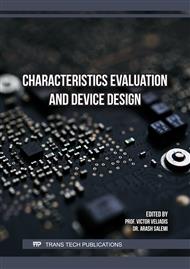[1]
X. Yuan, I. Laird, S. Walder, Opportunities, challenges, and potential solutions in the application of fast-switching SiC power devices and converters, IEEE Trans. Power Electron. 36 (2021) 3925-3945.
DOI: 10.1109/tpel.2020.3024862
Google Scholar
[2]
K. Mairhofer, S. Larisegger, A. Foelske, M. Sauer, G. Friedbacher, G. Fafilek, New insights into the photoassisted anodic reactions of n-type 4H SiC semiconductors, Monatsh. Chemie 155 (2024) 683-696.
DOI: 10.1007/s00706-024-03212-5
Google Scholar
[3]
S. Whiteley, A. Sorensen, J. J. Vajo, R. Sfadia, T. D. Ladd, S. Cui, J. Graetz, Dopant selective photoelectrochemical etching of SiC, J. Electrochem. Soc. 170 (2023) 036508.
DOI: 10.1149/1945-7111/acc553
Google Scholar
[4]
M. Leitgeb, G. Pfusterschmied, S. Schwarz, B. Depuydt, J. Cho, U. Schmid, Communication-current oscillations in photoelectrochemical etching of monocrystalline 4H silicon carbide, ECS J. Solid State Sci. Technol. 10 (2021) 073003.
DOI: 10.1149/2162-8777/ac10b3
Google Scholar
[5]
M. Leitgeb, C. Zellner, M. Schneider, U. Schmid, Porous single crystalline 4H silicon carbide rugate mirrors APL Mater. 5 (2017) 106106.
DOI: 10.1063/1.5001876
Google Scholar
[6]
M. Leitgeb, C. Zellner, C. Hufnagl, M. Schneider, S. Schwab, H. Hutter, U. Schmid, Stacked layers of different porosity in 4H SiC substrates applying a photoelectrochemical approach, J. Electrochem. Soc. 164 (2017) E337.
DOI: 10.1149/2.1081712jes
Google Scholar
[7]
C. S. Solanki, R. R. Bilyalov, J. Poortmans, J. Nijs, R. Mertens, Porous silicon layer transfer processes for solar cells, Sol. Energ. Mater. Sol. C. 83 (2004) 101-113.
DOI: 10.1016/j.solmat.2004.02.016
Google Scholar
[8]
M. Xu, Y. R. Girish, P. Wu, H. M. Manukumar, S. M. Byrappa, Udayabhanu, K. Byrappa, Recent advances and challenges in silicon carbide (SiC) ceramic nanoarchitectures and their applications, Mater. Today Commun. 28 (2021) 102533.
DOI: 10.1016/j.mtcomm.2021.102533
Google Scholar
[9]
G. Tuci, Y. Liu, A. Rossin, X. Guo, C. Pham, G. Giambastiani, C. Pham-Huu, Porous silicon carbide (SiC): a chance for improving catalysts or just another active-phase carrier? Chem. Rev. 121 (2021) 10559-10665.
DOI: 10.1021/acs.chemrev.1c00269
Google Scholar
[10]
M. Leitgeb, C. Zellner, M. Schneider, U. Schmid, A combination of metal assisted photochemical and photoelectrochemical etching for tailored porosification of 4H SiC substrates, ECS J. Solid State Sci. Technol. 5 (2016) P556.
DOI: 10.1149/2.0041610jss
Google Scholar
[11]
S. Dhar, O. Seitz, M. D. Halls, S. Choi, Y. J. Chabal, L. C. Feldman, Chemical properties of xxidized silicon carbide surfaces upon etching in hydrofluoric acid, J. Am. Chem. Soc. 131 (2009) 16808-16813.
DOI: 10.1021/ja9053465
Google Scholar
[12]
P. Giannozz, S. Baroni, N. Bonini, M. Calandra, R. Car, C. Cavazzoni, D. Ceresoli, G. L. Chiarotti, M. Cococcioni, I. Dabo, et al., QUANTUM ESPRESSO: a modular and open-source software project for quantum simulations of materials, J. Phys.: Condens. Matter 21 (2009) 395502.
DOI: 10.1088/0953-8984/21/39/395502
Google Scholar
[13]
G. Prandini, A. Marrazzo, I. E. Castelli, N. Mounet, N. Marzari, Precision and efficiency in solid-state pseudopotential calculations, Npj Comput. Mater. 4 (2018) 72.
DOI: 10.1038/s41524-018-0127-2
Google Scholar
[14]
A. L. Hannam and P. T. B. Shaffer, Revised X-ray diffraction line intensities for silicon carbide polytypes, J. Appl. Crystallogr. 2 (1969) 45-48.
DOI: 10.1107/s0021889869006510
Google Scholar
[15]
S. Grimme, J. Antony, S. Ehrlich, H. Krieg, A consistent and accurate ab initio parametrization of density functional dispersion correction (DFT-D) for the 94 elements H-Pu, J. Chem. Phys. 132 (2010) 154104.
DOI: 10.1063/1.3382344
Google Scholar
[16]
E. Rauls, Z. Hajnal, P. Deák, T. Frauenheim, Theoretical study of the nonpolar surfaces and their oxygen passivation in 4H- 6H-SiC, Phys. Rev. B 64 (2001) 245323.
DOI: 10.4028/www.scientific.net/msf.338-342.365
Google Scholar
[17]
G. Wulff, On the question of speed of growth and dissolution of crystal surfaces, Z. Kristallogr, 34 (1901) 449.
Google Scholar
[18]
X.-G. Wang, A. Chaka, M. Scheffler, Effect of the environment on alpha-Al2O3 (0001) surface structures, Phys. Rev. Lett. 84 (2000) 3650-3653.
Google Scholar
[19]
G. Cicala, P. Capezzuto, G. Bruno, M. C. Rossi, Growth chemistry of SiC alloys from SiF4-CH4 plasmas, Appl. Surf. Sci. 184 (2001) 66-71.
DOI: 10.1016/s0169-4332(01)00665-1
Google Scholar
[20]
H. Suzuki, H. Araki, M. Tosa, T. Noda, SiC film formation from fluorosilane gas by plasma CVD, J. Cryst. Growth 294 (2006) 464-468.
DOI: 10.1016/j.jcrysgro.2006.07.003
Google Scholar
[21]
K. Reuter, M. Scheffler, Composition, structure, and stability of RuO2 (110) as a function of oxygen pressure, Phys. Rev. B 65 (2001) 035406.
Google Scholar


